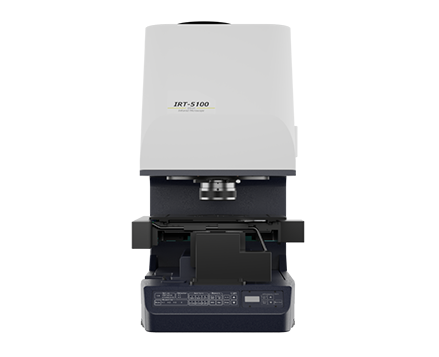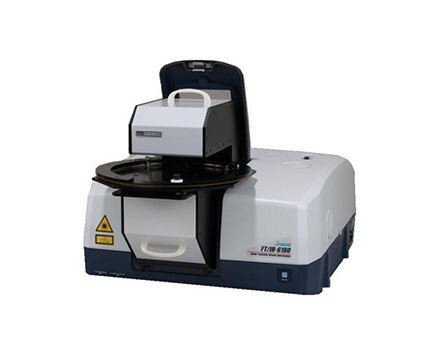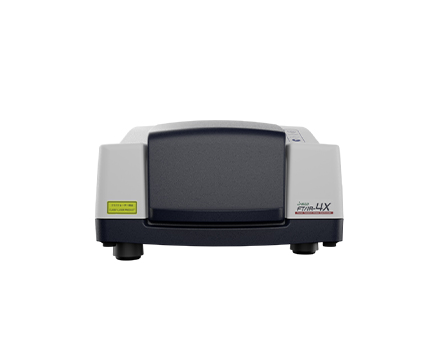Measurement of Thin Films by Polarization-Modulation Infrared Reflection-Absorption Spectroscopy (PM-IRRAS)
May 2, 2024
Introduction
This report outlines a Polarization-Modulation Infrared Reflection-Absorption Spectroscopy (PM-IRRAS) system, with examples of sample data from the measurement of thin films. Several industrial products utilizing the advanced functionalities of thin films such as electric, optical, and/or mechanical properties are now becoming more popular, and techniques for the manufacture and evaluation of these films has steadily improved. Infrared spectroscopy is well known as one of the most useful evaluation methods for these types of thin films, providing information on molecular structure and orientation, along with optical thickness and electric properties. Infrared Reflection-Absorption Spectroscopy (IRRAS) is useful for molecular structure analysis of a very thin films on metal substrates with a thickness in the region of tens of angstroms. However, there is a growing need for higher sensitivity measurement, and also process monitoring of film generation because of the development of newer devices that require higher performance and increased functionality. To meet this requirement JASCO has developed a monitoring system for film generation in a vacuum chamber using Polarization- Modulation Infrared Reflection-Absorption Spectroscopy (PM-IRRAS) with greater sensitivity than ordinary IRRAS.
Principle of PM-IRRAS

IRRAS provides IR spectra measurement of thin films on metal substrates with high sensitivity using a p-polarized light parallel to the plane of incidence. The p-polarized light generates an electric field with stationary vibration which increases sensitivity (see Fig.1); this allows film thickness measurement at the angstrom level. However, absorption peaks obtained by IRRAS are usually very small, and often require a long accumulation time. In addition, both a reference and a sample substrate must be measured. For these reasons, the spectra can be significantly affected by the absorption of atmospheric H2O and CO2. On the other hand, PM-IRRAS is a method for finding the intensity difference in s- and p-polarized light (ΔI = Ip – Is) – vertical and parallel to the plane of incidence respectively using a Photoelastic Modulator (PEM). As s-polarized light does not generate an electric field of stationary vibration, the absorption is much smaller than that of p-polarized light. In addition, in PM-IRRAS, the sum of s- and p- polarization signals (Σ I = Ip + Is) is used as a reference and so there is no need to measure a reference substrate. Hence, the effect due to the absorption of atmospheric H2O and CO2; can be greatly decreased. As the measurement of a reference substrate is not required, the results are free from the effect of differences between substrates and the overall measurement time can be shortened. PM-IRRAS measurement allows higher sensitivity by detecting small ΔI signals using a direct lock-in detection by adopting dual modulation spectroscopy of the FTIR interferometer and PEM.
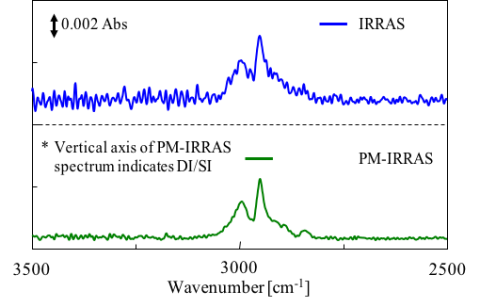
Fig. 2 shows the results of a PMAA thin film on an Al mirror measured by IRRAS and PM-IRRAS with all other conditions remaining the same. The S/N of spectra obtained using PM-IRRAS are several times better than IRRAS.
Experimental
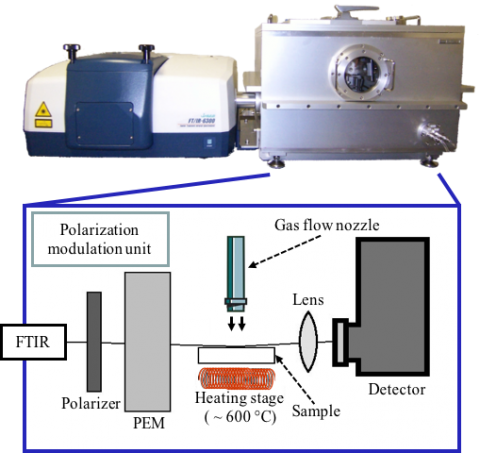
System layout of polarization modulation unit (lower)
Fig. 3 PM-IRRAS measurement system and system layout of the polarization modulation unit. While the optimal incidence angle is generally considered to be in the range 80 ~ 89° depending on the type of metal and the wavenumber of the incident light, the angle of incidence of the polarized light in this system is 85°. In addition, the entire system can be subject to a vacuum. In principle, PM-IRRAS can greatly reduce the noise contribution from H2O and CO2, but vacuum optics can enhance the sensitivity still farther. As standard the system can flow gas onto the sample or heated sample, enabling it to be used for monitoring a film during the generation process, or evaluating structural changes.
Keywords
260-PR-0231, PM-IRRAS, FTIR reflectance spectroscopy, thin film measurement
Results
Measurement Example
1. PMMA Thin Film on an Al Mirror
The result of PMMA measurement of a thin film on an Al mirror is shown in Fig. 4. The spectrum has good S/N without the influence of H2O.

2. Aluminum Oxide Layer on Al Mirror
Measurement of a native oxidation film on an Al mirror is shown in Fig.5. The thickness of the native oxidation film obtained using ellipsometry (JASCO: M-220) is 46.9 Å and it is confirmed that the measurement of thickness at the Å level was made in approx. 1 minute using PM-IRRAS.

Featured Products:

Measurement of Thin Films by Polarization-Modulation Infrared Reflection-Absorption Spectroscopy (PM-IRRAS)
Introduction
This report outlines a Polarization-Modulation Infrared Reflection-Absorption Spectroscopy (PM-IRRAS) system, with examples of sample data from the measurement of thin films. Several industrial products utilizing the advanced functionalities of thin films such as electric, optical, and/or mechanical properties are now becoming more popular, and techniques for the manufacture and evaluation of these films has steadily improved. Infrared spectroscopy is well known as one of the most useful evaluation methods for these types of thin films, providing information on molecular structure and orientation, along with optical thickness and electric properties. Infrared Reflection-Absorption Spectroscopy (IRRAS) is useful for molecular structure analysis of a very thin films on metal substrates with a thickness in the region of tens of angstroms. However, there is a growing need for higher sensitivity measurement, and also process monitoring of film generation because of the development of newer devices that require higher performance and increased functionality. To meet this requirement JASCO has developed a monitoring system for film generation in a vacuum chamber using Polarization- Modulation Infrared Reflection-Absorption Spectroscopy (PM-IRRAS) with greater sensitivity than ordinary IRRAS.
Principle of PM-IRRAS

IRRAS provides IR spectra measurement of thin films on metal substrates with high sensitivity using a p-polarized light parallel to the plane of incidence. The p-polarized light generates an electric field with stationary vibration which increases sensitivity (see Fig.1); this allows film thickness measurement at the angstrom level. However, absorption peaks obtained by IRRAS are usually very small, and often require a long accumulation time. In addition, both a reference and a sample substrate must be measured. For these reasons, the spectra can be significantly affected by the absorption of atmospheric H2O and CO2. On the other hand, PM-IRRAS is a method for finding the intensity difference in s- and p-polarized light (ΔI = Ip – Is) – vertical and parallel to the plane of incidence respectively using a Photoelastic Modulator (PEM). As s-polarized light does not generate an electric field of stationary vibration, the absorption is much smaller than that of p-polarized light. In addition, in PM-IRRAS, the sum of s- and p- polarization signals (Σ I = Ip + Is) is used as a reference and so there is no need to measure a reference substrate. Hence, the effect due to the absorption of atmospheric H2O and CO2; can be greatly decreased. As the measurement of a reference substrate is not required, the results are free from the effect of differences between substrates and the overall measurement time can be shortened. PM-IRRAS measurement allows higher sensitivity by detecting small ΔI signals using a direct lock-in detection by adopting dual modulation spectroscopy of the FTIR interferometer and PEM.

Fig. 2 shows the results of a PMAA thin film on an Al mirror measured by IRRAS and PM-IRRAS with all other conditions remaining the same. The S/N of spectra obtained using PM-IRRAS are several times better than IRRAS.
Experimental

System layout of polarization modulation unit (lower)
Fig. 3 PM-IRRAS measurement system and system layout of the polarization modulation unit. While the optimal incidence angle is generally considered to be in the range 80 ~ 89° depending on the type of metal and the wavenumber of the incident light, the angle of incidence of the polarized light in this system is 85°. In addition, the entire system can be subject to a vacuum. In principle, PM-IRRAS can greatly reduce the noise contribution from H2O and CO2, but vacuum optics can enhance the sensitivity still farther. As standard the system can flow gas onto the sample or heated sample, enabling it to be used for monitoring a film during the generation process, or evaluating structural changes.
Keywords
260-PR-0231, PM-IRRAS, FTIR reflectance spectroscopy, thin film measurement
Results
Measurement Example
1. PMMA Thin Film on an Al Mirror
The result of PMMA measurement of a thin film on an Al mirror is shown in Fig. 4. The spectrum has good S/N without the influence of H2O.

2. Aluminum Oxide Layer on Al Mirror
Measurement of a native oxidation film on an Al mirror is shown in Fig.5. The thickness of the native oxidation film obtained using ellipsometry (JASCO: M-220) is 46.9 Å and it is confirmed that the measurement of thickness at the Å level was made in approx. 1 minute using PM-IRRAS.


 Download This Application
Download This Application